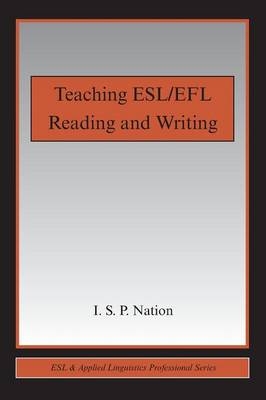
Teaching ESL/EFL Reading and Writing
Routledge (Verlag)
978-0-415-98968-8 (ISBN)
- Titel erscheint in neuer Auflage
- Artikel merken
Using a framework based on principles of teaching and learning, this guide for teachers and teacher trainees provides a wealth of suggestions for helping learners at all levels of proficiency develop their reading and writing skills and fluency. By following these suggestions, which are organized around four strands – meaning-focused input, meaning-focused output, language-focused learning, and fluency development – teachers will be able to design and present a balanced program for their students.
Teaching ESL/EFL Reading and Writing, and its companion text, Teaching ESL/EFL Listening and Speaking, are similar in format and the kinds of topics covered, but do not need to be used together. Drawing on research and theory in applied linguistics, their focus is strongly hands-on, featuring
easily applied principles,
a large number of useful teaching techniques, and
guidelines for testing and monitoring,
All Certificate, Diploma, Masters and Doctoral courses for teachers of English as a second or foreign language include a teaching methods component. The texts are designed for and have been field tested in such programs.
I.S.P. Nation is Professor of Applied Linguistics in the School of Linguistics and Applied Language Studies at Victoria University in Wellington, New Zealand.
@contents: Selected Contents:
Table of Contents
Chapter 1 Learning to read in another language 1
Learning to read in the first language
Learning to read in another language
Principles for teaching reading
Chapter 2 Learning to recognise and spell words
Prerequisites for formal reading instruction
Phonics and the alphabetic principle
The role of phonics in a reading programme
Spelling: productive phonics
Learning to spell
Designing a focused spelling programme
Chapter 3 Intensive reading
Focuses in intensive reading
Features of a good reading exercise
Are comprehension questions good reading exercises?
Comprehension of the text
The focus of comprehension questions
Grammar features in the text
Cohesive devices
Strategy development
Standardized reading procedures
Handling the exercises
The role of teaching exercises
Chapter 4 Extensive reading
Understand the goals and limitations of extensive reading
Find your learners= present vocabulary level
Provide plenty of interesting and appropriate reading texts
Set, encourage and monitor large quantities of extensive reading
Support and supplement extensive reading with language focused learning and fluency development
Help learners move systematically through the graded reader levels
Simplified and unsimplified texts
The extensive reading programme
Chapter 5 Reading faster
The nature and limits of reading speed
The nature of fluency development
The nature of fluency development activities
Increasing oral reading speed
Increasing careful silent reading speed
Increasing silent expeditious reading speed
Frequently asked questions about reading speed
Chapter 6 Assessing reading
Motivating
Measuring achievement
Diagnosing problems
Measuring reading proficiency
Issues in making and using comprehension tests
Chapter 7 Helping learners write
Principles for teaching writing
Designing tasks
Experience tasks
Bringing tasks within the learners' experience
Making sure learners have the experience to do a task
Shared tasks
Guided tasks
Independent tasks
Using the four kinds of tasks
Chapter 8 The writing process
The parts of a writing programme
Meaning-focused writing
The parts of the writing process
Considering the goals of the writer and model of the reader
Gathering ideas
Ideas to text
Editing
Reviewing
Diagnosing control of the parts of the writing process
Diagnosing from the written product
Chapter 9 Topic types
The topic type hypothesis
Topic types and writing
Topic types and reading
Limitations of the topic type approach
Chapter 10 Responding to written work
Motivating
Improving the quality of writing
Measuring proficiency in writing
Appendix 1 Spelling correspondences
Appendix 2 Conjunction relationships
References
| Erscheint lt. Verlag | 15.10.2008 |
|---|---|
| Reihe/Serie | ESL & Applied Linguistics Professional Series |
| Zusatzinfo | 15 Tables, black and white |
| Verlagsort | London |
| Sprache | englisch |
| Maße | 152 x 229 mm |
| Gewicht | 771 g |
| Themenwelt | Schulbuch / Wörterbuch ► Wörterbuch / Fremdsprachen |
| Geisteswissenschaften ► Sprach- / Literaturwissenschaft ► Sprachwissenschaft | |
| Sozialwissenschaften ► Pädagogik | |
| ISBN-10 | 0-415-98968-X / 041598968X |
| ISBN-13 | 978-0-415-98968-8 / 9780415989688 |
| Zustand | Neuware |
| Haben Sie eine Frage zum Produkt? |
aus dem Bereich



